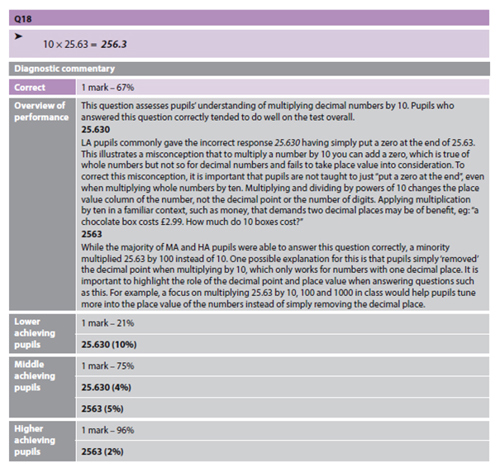The value of diagnostic assessment in year 6
Summative assessment features prominently in many year 6 classrooms in England, often in the lead up to the end of year national curriculum tests. It’s important that maximum value is gained from the time devoted to assessment, including the time required by teachers to mark pupils’ work.
For this reason, NFER has spent much of the last year developing diagnostic feedback from new tests for use in the autumn and spring terms of year 6. This has been produced by analysing the responses to the questions given by the large nationally representative sample that trialled the tests.
Dylan Wiliam distinguishes between diagnostic and formative assessment, suggesting that ‘diagnostic’ should refer to those assessments that provide information about the difficulties that a pupil is experiencing, and ‘formative’ to those that provide feedback to learners about how to improve.
The new diagnostic guides, which are included with our year 6 teacher guides, contain commentaries for most of the questions within the new tests. They identify common incorrect answers and the reasons why pupils might be giving these, such as a misconception in their knowledge or a particular skill that needs to be developed. The commentaries also provide suggestions for the next steps in teaching to address these misconceptions or lack of skills. By scrutinising their own pupils’ performance and comparing this to the common areas of weakness described in the diagnostic guides, teachers can plan to address the curriculum areas appropriate to their pupils and provide them with opportunities to practise skills which require further work.
A particularly novel feature of the diagnostic guidance is that it is tailored to the ability of the pupils. During the analysis we noted that, while some mistakes were made by pupils of all ability levels, other errors were indicative of a particular achievement group: lower achieving pupils, middle achieving pupils or higher achieving pupils. It has enabled us to direct the guidance more appropriately so that teachers can easily see how to improve the attainment of lower achieving pupils whilst also providing extension to more able pupils.
Extract from the NFER Tests year 6 diagnostic guidance

Further information provided by the diagnostic guides includes patterns of performance across a test looking at, for example, whole text understanding in reading and approaches to problem solving questions in maths. The reading diagnostic guide also details further discussion and activities that can be used in classes to make the most of these rich texts.
Whether or not a test is appropriate (or the best to use) is dependent on the whether or not it provides suitable evidence which aligns with the purposes for its use. In assessment theory, an assessment’s validity concerns how well it fulfils its purpose. We believe that these new tests provide both summative information but also unique diagnostic information which inform teaching and learning.
NFER’s new year 6 standardised tests are available for use in the autumn and spring terms in reading, mathematics and grammar, punctuation and spelling. The tests mirror the format and content of the national curriculum statutory tests. This enables pupils to practise the full range of question types including those asking them to give a written explanation or reasoned argument. Such questions often require pupils to demonstrate a more developed comprehension as well as the skill to articulate their understanding. Although we would not recommend that pupils are taught to the test or spend excessive time practising test taking, some familiarity with expectations can make the statutory test less daunting.
